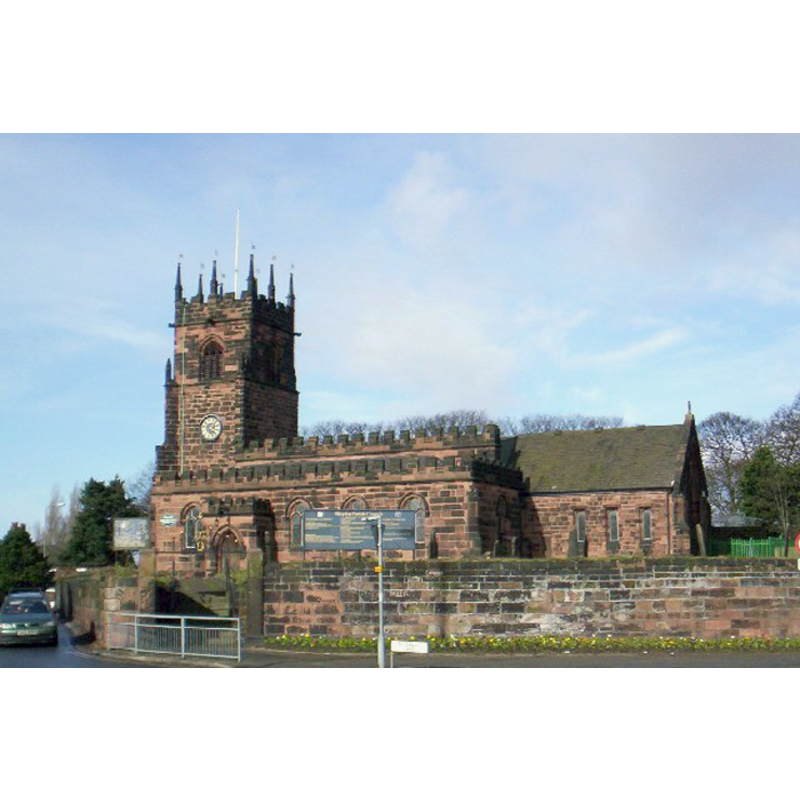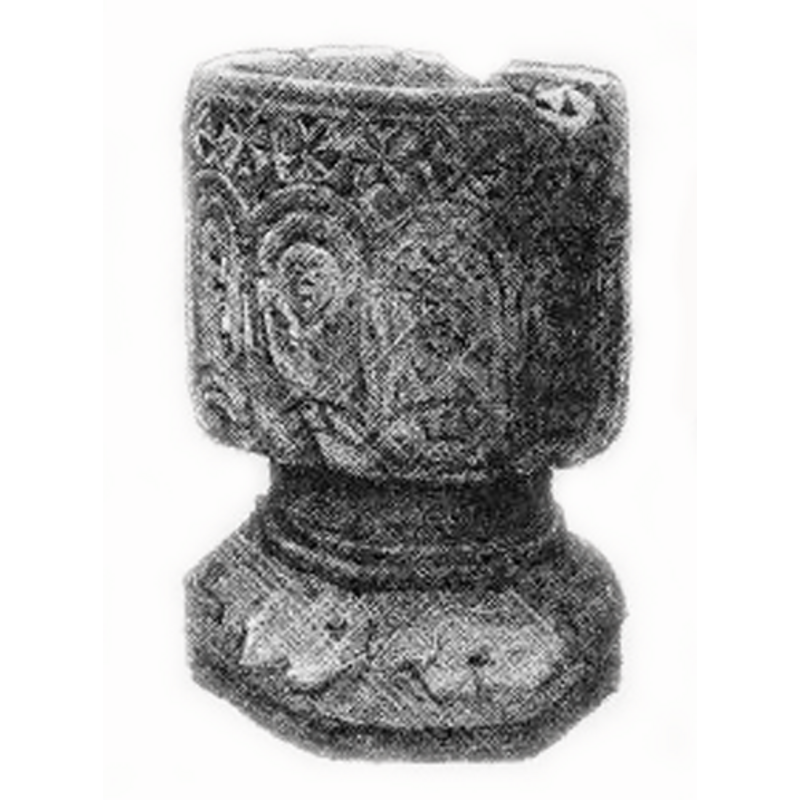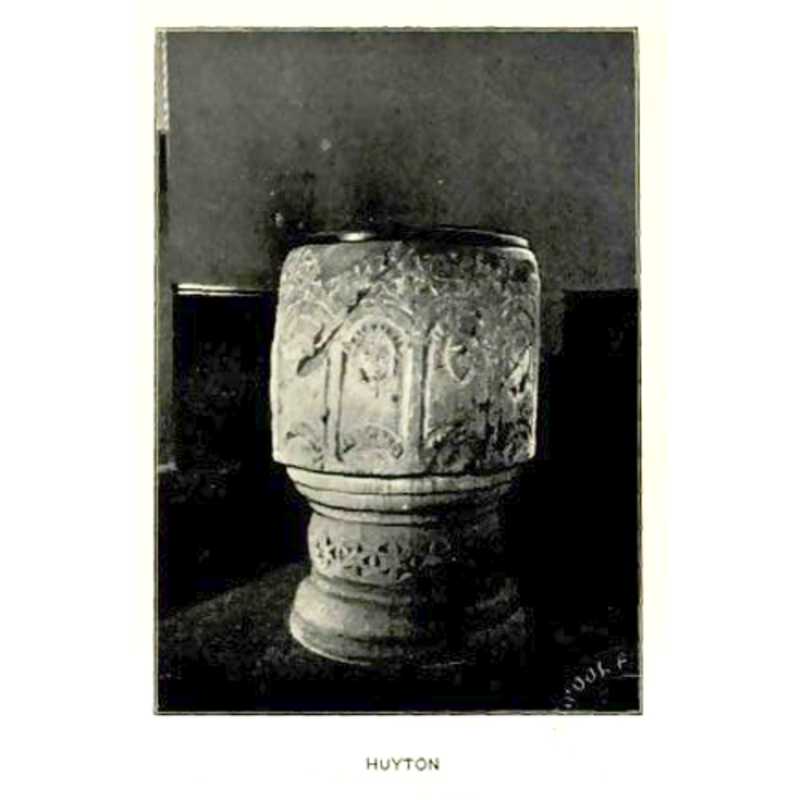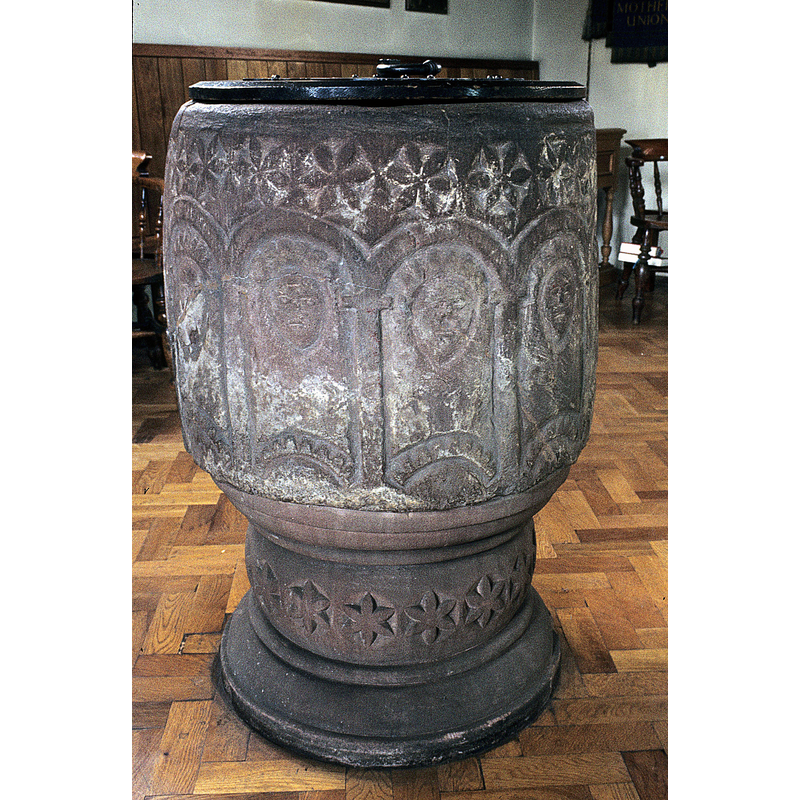Huyton No. 1 / Hitune
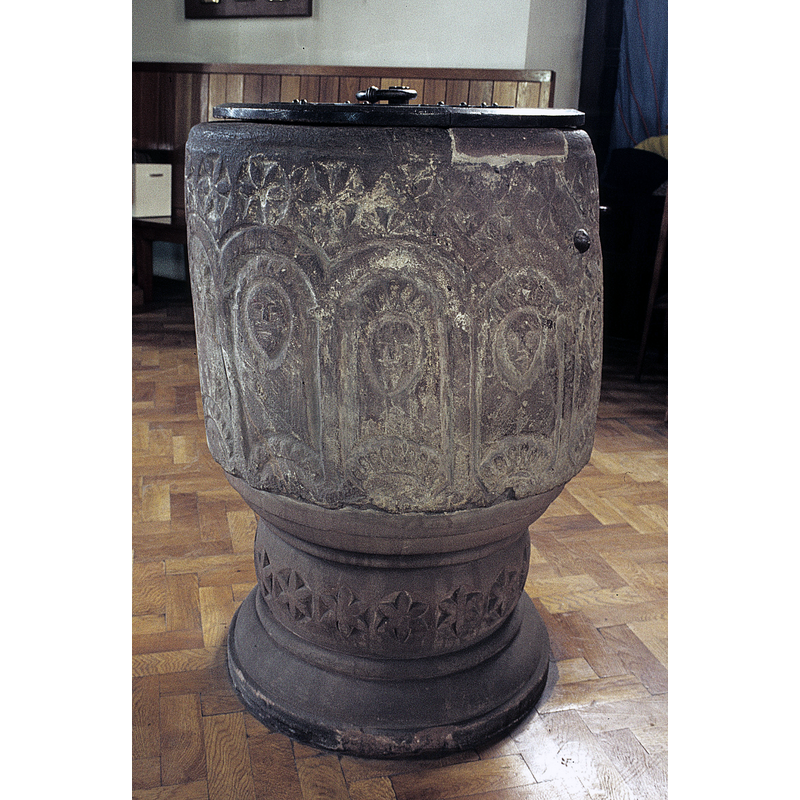
Image copyright © Timothy Marlow, 2014
Image and permission received (letter of 26 October 2013)
Results: 11 records
design element - architectural - arcade - round arches - 11 arches - columns with capitals
design element - motifs - crenelated arch
human figure - head - 11
Scene Description: not clear whether they are just heads or busts; one in each of the arches of the arcade [cf. Font notes]
Copyright Statement: Image copyright © Timothy Marlow, 2014
Image Source: detail of a photograph taken 16 April 1983 by Timothy Marlow
Copyright Instructions: Image and permission received (letter of 26 October 2013)
symbol - rosette or star - 5-points
symbol - star - 6-point - in a circle
view of church exterior - southeast view
view of font
Scene Description: shown here before the restoration; the base had mouldings at the base of the short stem, and some sort of decoration on the splaying lower part; the large damage at the ipper rim was repaired with new stone inserts
Copyright Statement: Image copyright © [in the public domain]
Image Source: edited detail of a drawing by "J E Warrall, del", in Smith (1874)
Copyright Instructions: PD
view of font and cover
view of font and cover
view of font and cover
INFORMATION
FontID: 01544HUY
Object Type: Baptismal Font1
Church/Chapel: Parish Church of St. Michael
Church Patron Saints: St. Michael
Church Location: Blue Bell Lane, Huyton, Merseyside, L36 7SE
Country Name: England
Location: Merseyside, North West
Directions to Site: Located 10-12 km E of Liverpool
Ecclesiastic Region: Diocese of Liverpool
Historical Region: formerly in Lancashire -- Hundred of West Derby
Font Location in Church: Inside the church, reported at the E end of the S aisle in 1907
Century and Period: 12th century (early?), Early Norman? / Norman?
Font Notes:
Click to view
There is an entry for Huyton [variant spelling] in the Domesday survey [http://domesdaymap.co.uk/place/SJ4491/huyton/] [accessed 25 June 2014], but it makes no mention of church or cleric in it. A font is noted and illustrated in Smith (1874), who reports the discovery of "the bowl or basin of a font, clearly of much older character than any portions of the present structure, the earliest of which seem to belong to the 15th century [...] This font-bowl, which has unquestionably possessed a pedestal [...] has been carved from a single block of the native (Keuper) red sandstone"; Smith )ibid.) further notes "hollows on each side" of the upper rim of the basin for anchoring the hardware a font cover. "The font was found to possess its lining of lead, bearing traces of long-continued use, still whole and only rather jagged at the rim. This metal receptacle has a depth of 12 and a diameter of 20 inches." Smith (ibid.) proceeds with a detailed description of the low-relief carving [cf. infra] and states: "In regard to date, we hold both the Grappenhall and the Huyton font to be of as early a character as any we remeber to have seen of heard of in this country, and incline to attribute them to the 8th or 9th century, when Roman sculpture still remained strewed over the land; for the style of ornament seems to decide the point, and the mode of execution confirms the appropriation. The six-petalled flowers are only so far Saxon or Norman, copied from Roman-British altars and monumental stones; in later mediaeval times only recognised Christian emblems would have been used for so sacred a purpose as this, and in place of these flowers, cinquefoils or trefoils would have been substituted. The arcades are likewise derived from Roman archwork of the severest style, whilst the saints, unlike those of later sculpture, are devoid of any symbols. The most expressive term for this copied and debased style is, perhaps, 'degraded Roman'." Smith (ibid.) proceeds then to point out the similarities and differences of the fonts at Grappenhall and Huyton. Ellis (1902) notes the font with much of the content from Smith [cf. supra], whom he quotes extensively. Cox & Harvey (1907) list a Norman font, one of two fonts in this church [cf. Index entry for Huyton No. 2 for the second one]. The Victoria County History (Lancaster, vol. 3, 1907) has: "at the east end of the south aisle is a second font, found under the west tower in 1873. It belongs to the first half of the 12th century, and has a round bowl ornamented with eleven arched panels, in each of which is a human head, and above a row of five-pointed stars [...] It is set on a modern pedestal." Noted in Pevsner (1969), also as one of two: "One is Early Norman [...] The Norman one is tub-shaped and has extremely primitive heads in arcading, and a frieze of rosettes above." Ditto in Pollard & Pevsner (2006). A recent [1998] illustration of this font appears in the Knowsley Metropolitan Borough Council, [http://history.knowsley.gov.uk] [Ref. No. WFN145 -- Date of photo: 1998]
COORDINATES
Church Latitude & Longitude Decimal: 53.414018, -2.840066
Church Latitude & Longitude DMS: 53° 24′ 50.47″ N, 2° 50′ 24.24″ W
UTM: 30U 510630 5918340
MEDIUM AND MEASUREMENTS
Material: stone, sandstone
Font Shape: tub-shaped (mounted)
Basin Interior Shape: round
Basin Exterior Shape: round
Diameter (inside rim): 48.26 cm*
Diameter (includes rim): 66.04 cm*
Basin Depth: 27.94 cm*
Basin Total Height: 55.88 cm*
Font Height (less Plinth): 83.82 cm*
Notes on Measurements: * [in inches in Ellis (1902: 71)]
LID INFORMATION
Date: modern?
Material: wood
Apparatus: no
Notes: round and flat, with metal ring handle; appears modern
REFERENCES
Victoria County History [online], University of London, 1993-. Accessed: 2006-09-11 00:00:00. URL: https://www.british-history.ac.uk.
Cox, John Charles, English Church Furniture, New York: E.P. Dutton & Co., 1907
Ellis, John W., "The Mediaeval Fonts of the Hundreds of West Derby and Wirral", LVIII (New series: XVII), Transactions of the Historic Society of Lancashire and Cheshire, 1902, pp. 59-80; p. 70-71
Pevsner, Nikolaus, Lancashire, Harmondsworth: Penguin Books, 1969
Pollard, Richard, Lancashire: Liverpool and the South-West, New Haven, London: Yale University Press, 2006
Smith, Henry Ecroyd, "Archaeology of the Mersey District, 1873, and Liverpool Notabilia", II (3rd series), Transactions of the Historic Society of Lancashire and Cheshire, 1874, pp. [83]-139; p. 86-87
![[cf. Font notes]](/static-50478a99ec6f36a15d6234548c59f63da52304e5/compressed/1141109022_compressed.png)
